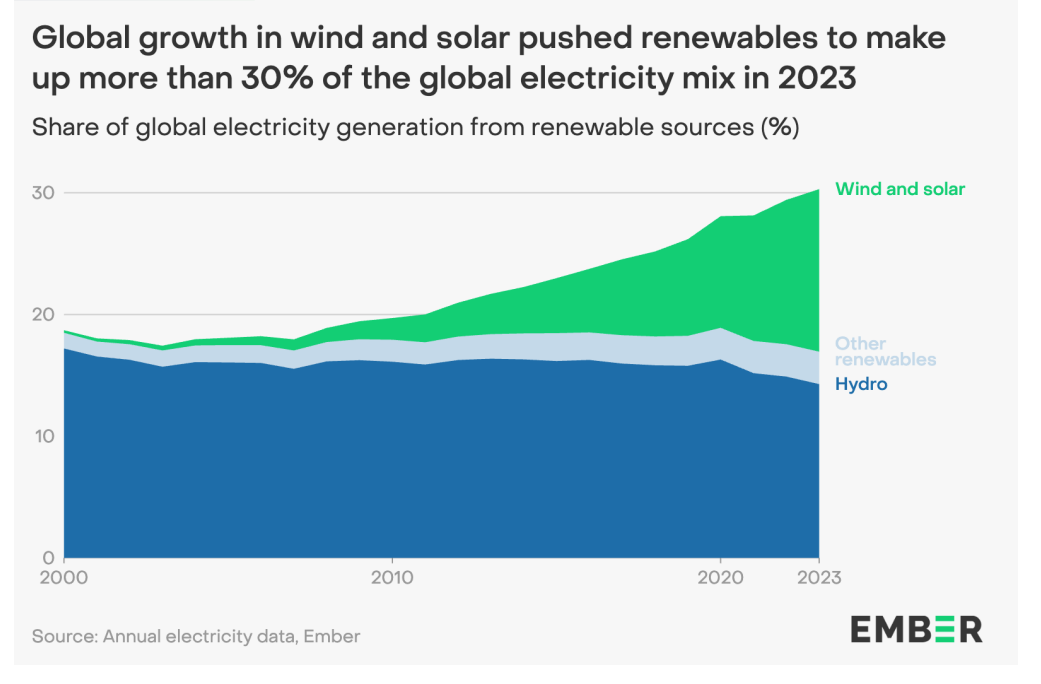Independent clean energy think tank Ember released a report recapping the growth of renewable energy worldwide, reporting that renewable energy generated about 30% of electricity across the globe in 2023.
Solar generation growth increased 23% globally, wind grew 10%, while fossil fuel generation grew only 0.8% last year, said the report. Renewables have expanded from 19% of global electricity in 2000, driven by an increase in solar and wind from 0.2% in 2000 to a record 13.4% in 2023.
“Solar is leading the energy revolution,” said the report. “It was the fastest-growing source of electricity generation for the 19th year in a row, and surpassed wind to become the largest source of new electricity for the second year running.”
China was the main contributor to solar growth in 2023, accounting for 51%. Other major contributors were the EU (12%) and the U.S. (11%). Together the four solar growth economies, China, EU, the U.S., and Brazil, accounted for 81% solar growth in 2023.
Solar reached a 5.5% share of the global electricity mix, reaching 1,631 TWh, rising from 4.6% in 2022.
“Despite reaching new record highs, the absolute growth in wind and solar (+513 TWh) was below expectations and slightly smaller than in 2022 (+517 TWh). This was mainly due to lower-than-expected wind growth, which was 18% lower compared to the 249 TWh increase in 2022,” said Ember.
Demand for electricity grew by 637 TWh globally in 2023, rising 2.2%, or the equivalent of adding the entire electricity demand of Canada to the total. This brought global electricity demand to a record 29,471 TWh. The increase in demand in 2023 was slightly lower than the average annual increase over the previous decade of 2.5%.
Solar and wind met most of the increased electricity demand globally, adding 513 TWh of generation, or about 82% of new demand.
“Despite their lower-than-expected growth, solar and wind were the powerhouses of newly added clean electricity,” said the report. “In aggregate, all other clean electricity sources fell – small rises in bioenergy and nuclear were not enough to counter the large fall in hydro generation caused by extensive droughts. Together, all clean sources met 79% of the increase in electricity demand, creating a shortfall that was met by fossil generation.”
The unprecedented growth of solar energy is leading the charge toward a carbon-free energy system, said Ember. In the decade of 2000 to 2010 cumulative global capacity doubled every two years, then from 2010 to 2023 the rate slowed to doubling every three years. The International Energy Agency (IEA) said that if solar deployment continues along an arc of doubling every 3.8 years from 2023 to 2030, the world will be on-pace for its Net Zero Economy scenario.
“Solar capacity has boomed due to steep declines in costs, supportive policy environments, technology efficiency improvements, and increased manufacturing capability,” said Ember. “A key to the rapid rise is Wright’s law of technology learning curves, whereby the technology gets cheaper as it is deployed more and it is deployed more as it gets cheaper.”
Combined with nuclear, the world generated about 40% of its electricity from low-carbon sources in 2023. Ember said this has resulted in CO2 intensity of global power generation falling 12% lower than its peak in 2007.
However, despite the average emissions per unit of energy generated decreasing in 2023, carbon emissions are higher than ever. Absolute fossil fuel generation increased 0.8% over the year, and global emissions increased by 1%, reaching 14,153 million tons of CO2 emitted by electricity generation.
“2023 came very close to becoming the first year of a new era of falling power sector emissions,” said Ember. “As clean electricity growth continues, we have growing confidence that in 2024, it will rise above electricity demand and lead to a fall in emissions.”
Clean energy capacity growth was already large enough to deliver a decline in emissions 2023, but a record fall in hydropower generation due to droughts prevented that. Ember said that 2023 likely marked the peak of power sector emissions.
“A signal is emerging from the noise of year-on-year variability: the world is at the peak, and about to enter a new era of falling power sector emissions,” said Ember.

This content is protected by copyright and may not be reused. If you want to cooperate with us and would like to reuse some of our content, please contact: editors@pv-magazine.com.









By submitting this form you agree to pv magazine using your data for the purposes of publishing your comment.
Your personal data will only be disclosed or otherwise transmitted to third parties for the purposes of spam filtering or if this is necessary for technical maintenance of the website. Any other transfer to third parties will not take place unless this is justified on the basis of applicable data protection regulations or if pv magazine is legally obliged to do so.
You may revoke this consent at any time with effect for the future, in which case your personal data will be deleted immediately. Otherwise, your data will be deleted if pv magazine has processed your request or the purpose of data storage is fulfilled.
Further information on data privacy can be found in our Data Protection Policy.